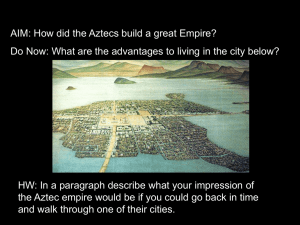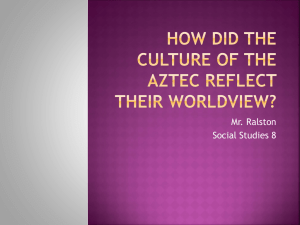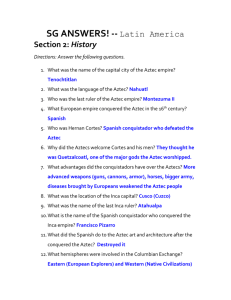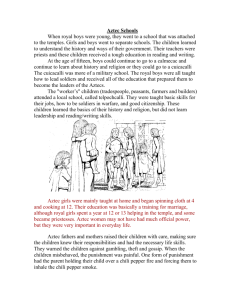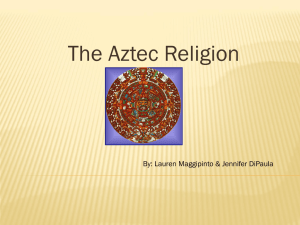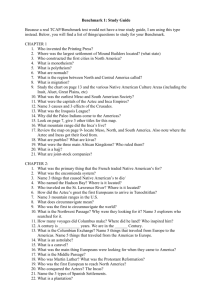Joe Pearson Cannibalism and Adaptation ANT 475 Human
advertisement
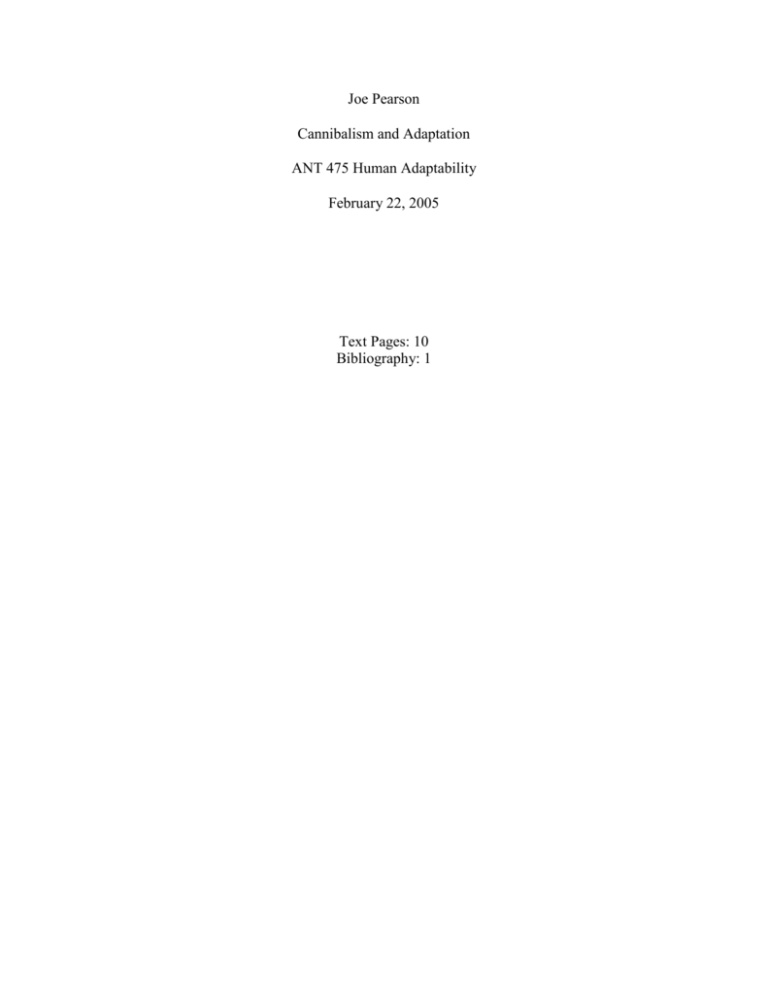
Joe Pearson Cannibalism and Adaptation ANT 475 Human Adaptability February 22, 2005 Text Pages: 10 Bibliography: 1 When people hear the word cannibal the images that tend to come to mind is Jeffery Dahmer, Hannibal Lector, or the movie Alive. This word evokes great fear yet one has to wonder what would make a human eat the flesh of another human being. Evidence of cannibalism can be found in some prehistoric hominid sites. There are many theories to why these different cultures practiced cannibalism. Peggy Sanday believes that cannibalism for the Aztec was a way for them to have closer relationship with their gods and to receive divine power. She attributes her theory to the fact that the Aztec practiced human sacrifice because they thought if they stopped offering blood and hearts to their gods they would destroy all of humanity. While Michael Harner believes that the Aztec practiced cannibalism because they lacked a sufficient amount of protein in their diet. The purpose of this paper is to examine some the reasons why societies practice cannibalism and to look at cannibalism as an adaptive practice. History and Types of Cannibalism The term f orc a nni ba l i s mc ome sf r omChr i s t ophe rCol umbus ’ se xpe di t i ono ft he Caribbean when he and his crew came across the Carib tribe who inhabited part of the lesser Antilles. When Columbus and his men failed to call them by their right name they mispronounced their name and called them Canib which turned into cannibal. We also have the Carib’ sto thank for the word barbeque which comes from the Carib word barbricot (Harris 1977:118). Before this term was introduced the Latin word anthropophagy was used to describe a human eating the flesh of another human. There are several different types of cannibalism: exocannibalism, endocannibalism, mortuary cannibalism, survival/nutritional cannibalism. Exocannibalism is a culture, group or tribe consumes on another culture, group, or tribe. Endoc a nni ba l i s mi st hec ons umpt i onofame mbe ri none ’ sownc ul t ur e ,gr oup,ortribe. 2 Mortuary cannibalism is the practice of eating deceased relative to maintain continuity with ones relative. Survival cannibalism is the act of eating human flesh during periods of extreme starvation. Nutritional cannibalism is performed when there is deficient amount of protein in the population. Hominid Cannibalism One of the questions that has plagued scientist is whether or not hominids practiced cannibalism. After much study and analysis of hominid remains most the evidence points out that they were not eating each other. What little evidence that we have for cannibalism can usually be disproved by naturally occurring phenomena such as broken long bones and shattered skulls could be caused by falling rocks or cut marks and teeth marks are usually made carnivorous animals. For example, in Choukoutien, China the broken remains of forty Sinanthropoids were found in cave. When the skulls were reconstructed they found that foramen magnum appeared to have been artificially enlarged. The condition of the broken bones can be explained by falling rocks however the artificial enlargement at the base of the skull is harder to explain. One theory is that the hole was enlarged to help preserve the skull in its intact form (Montagu 1976:125). Some of the best evidence for hominid cannibalism is found at sites inhabited by Neanderthals. One of these sites is a cave in southeastern France called the Moula-Guercy cave. Inside the cave were the remains of six Neanderthals that showed signs of hominid-induced modification. Both human and faunal remains showed similar processes in butchering. The cut marks on the bones seemed to have been made shortly after death and all the marrow bones had been broken into fragments that suggest this was done to extract the highly nutritional marrow 3 (Petronovich 1999:102). Cannibalism among Neanderthals is highly likely due to the extreme variation in climates that took place during the Pleistocene, with a reduction in wild animals for food, due to the fluctuation in climate; the Neanderthals would have been forced to practice survival cannibalism. If we move to the New World primarily to the Four Corners, where Utah, Colorado, New Mexico, and Arizona meet, we can find lots of examples cannibalism among the prehistoric Homo sapiens called the Anasazi. At the archaeological site 5MTUMR-2346 in Mancos Canyon 2,106 bone fragments were found, all but 114 were nonhuman (Petronovich 1999:106). These bones were from 29 individuals both male and female, which were made up of 17 adults and 12 children. Some of the remains showed signs of having dental enamel hypoplasia, which means there are transverse lines at the formation position. While another indicator of stress that shows up is porotic hyperostosis, a term that describes the pathological condition in which the supraorbital plate and the pericranial surfaces of the frontal, patrietal, and occipital (White 1992:95). Theses all indicate that there must have been various infectious diseases, dietary inadequacies, or nutritional stresses in the Anasazi. Getting back to the evidence of cannibalism the skeletal remains show signs of humaninduced toolmarks caused by defleshing, disarticulation, and percussion. There is evidence of heat alteration, little evidence of geological disturbance, and no evidence of alteration by nonhuman mammals. The theory that cannibalism was used as a survival tool is reinforced by the fact that none of the bone fragments were reworked into artifacts. “ One hint regarding the dynamics that drove cannibalism can be gained by examining the sex ratio of victims; the sites with cannibalism have nearly identical frequencies of adult males and females (which would be consistent with the hypothesis of either survival or ritual cannibalism), whereas those in which 4 there was only violence had remains of more than twice as many adult males than females” (Petronovich 1999:109-110). Through archaeological evidence we can see that cannibalism has existed since the time of early hominids, and further finds will only help to strengthen our record by new finds. Population Pressure Theory for Aztec Cannibalism I nMi c ha e lHa r ne r ’ sa r t i c l eThe Ecological Basis for Aztec Sacrifice he proposes that cannibalism was due to a growing population, a lack of domesticated herbivore for food production, and the depletion of wild animals, fish, and birds. He believes that human sacrifice was used as a disguise for cannibalism that was used to supplement their protein deficiency. Much of the information that Harner draws from are documents from the time of the Spanish Conquest, mostly written by the conquistadors and Spanish priests, and shortly after the Aztecs had been conquered. By looking at the extinction of big-game mammals caused by the Paleo-Indians we can see the first clear example of environmental degradation. Over time the growing population needed to domesticate plants and animals because, the amount of wild game and food plants were becoming harder to find. For the domestication plants to occur there has to be fertile soil and a climate that provides enough rainfall to support these plants. The environment of the Valley of Mexico, where the Aztec lived, was fertile and was well watered by the streams from the surrounding mountains which was suitable for domestication of plants. However the ancient hunters had already killed off all the potential herbivorous mammalian domesticates from the Mesoamerican area (Harner 1977:118). However, some species of Camelops, like the llama and alpaca, were able to survive being hunted into extinction and were later domesticated in the 5 Andean region and in southern South America. In the Mesoamerican region the focus was put on domesticating wild fowl, like turkey, and the dog for food. Since the dog was a carnivore this meant that it was not an efficient converter and it was also in competition with its breeders for animal protein. When it came to carbohydrate production the Aztec used chinampas, a rectangular stationary island that is used for growing crops, and other forms of agricultural intensification; but domesticated animal production was limited by the lack of a suitable herbivore. Nutritional Role of Cannibalism for the Aztec Aztec commoners rarely ate meat but, when they did it was usually venison or turkey. The elite were able to eat meat anytime they chose and they also had a wide variety of wild game to choose from. Commoners that lived near or around lakes could skim algae, which they called tecuitlatl, of the top of the water and formed it into cakes or they ate the nests of water-fly larvae. Commoner diets might also include iguanas, snakes, lizards, and worms. Although there was a lack of meat in the commoner diet they could get the eight essential amino acids from eating a combination of maize and beans. The only problem with this is both would have to be ingested in large amounts simultaneously or nearly simultaneously to provide the body with the eight essential amino acids for them to rebuild body tissue (Harner 1977:127). However, the Aztec experienced frequent food shortages like the one that happened in 1450 when the three rulers had to distribute out grain that had been stock piled for over ten years. The maize-bean combination could not be relied upon for the Aztec commoner to get the eight essential amino acids due to the fact the Aztec usually had crop failures that resulted in famines. 6 The Aztec commoner also had a lack of fats in their diet that was needed by the body to provide energy. “ I ti snot e wor t hyt ha tf a t t yme a t ,bypr ovi di ngbot hf a ta ndt hee s s e nt i a lpr ot e i ns , assures the utilization of the essential amino acids for tissue building, since the fat will provide the necessary source of energy that must also be supplied if the dietary protein is not to be s i phone dof fa sapur e l yc a l or i cc ont r i b ut i on”( Ha r ne r1977: 128) . It has been well documented that the Aztec held their captives in wooden cages prior to being sacrificed and the captives were usually well fed. By keeping the captives in cages and by feeding them only carbohydrates this would have caused a rapid buildup of fat, given enough caloric intake. Implications of Cannibalism among Aztec Commoners Although the Aztec elite prohibited the consumption of human flesh among commoners, there was a way for the lower class to obtain and consume human flesh. This could only be accomplished if the commoner joined the Aztec army and they were successful enough in taking captives during battles then they were able to become members of the Aztec elite. These new elites then provided cannibalistic feasts for there blood relatives which they served a stew of dried maize and human flesh called tlacatlaolli. These new elites primarily would distribute the flesh among their kin, rather than through the state structure. By allowing the lower class to participate in war through rewarding them with access to human flesh and elevating their status in society, the Aztec rulers were able to assemble the majority of the population, the poor, to contribute to state and the maintenance for the upper class through participation in military campaigns. Thusi twa si nt her ul i nge l i t e ’ si nt e r e s tt o restrict commoners from eating human flesh, since they were the ones who needed it the most. By letting the commoners participate in the military, to obtain human flesh, the ruling Aztec 7 were assured of an aggressive war machine. "And underlying the competitive success of that machine were the ecological extremities of the Valley of Mexico" (Harner 1977:130). Theories against Aztec Nutritional Cannibalism After Harner proposed that Aztec cannibalism was due to lack of protein in their diet many anthropologist and non-a nt hr opol og i s ts oonwr ot er e vi e wsdi s c l a i mi ngHa r ne r ’ st he o r y . Ones uc ha ut hort oc r i t i queHa r ne r ’ swor konAz t e cc a nni ba l i s mwa sdonebyanonanthropologist named Bernard R. Ortiz de Montellano. He argues that the malnutrition that occurred in the Indians of Mesoamerica was brought upon by substitution of European foodstuffs for the traditional dietary items. Montellano goes on to list several sources of wild and domestic vegetables proteins that provided a sufficient dietary base during the pre-Columbian era (Arens 1979:74). Montellano describes the famine that took place during 1450 and notes that instead of responding to the famine by increasing consumption of human flesh efforts were focused on intensifying agriculture and expanding military conquests to extract more tribute. Finally, he me nt i onst ha tmos tofHa r ne r ’ sdata comes from the conquistadors which, is problematic for s e ve r a lr e a s ons .Thef i r s toft he s epr o bl e msi sCor t e s ’a c c ounts to the King of Spain describing t heAz t e ca s“ s odomi t e swhos a c r i f i c eme n,wome n,a ndc hi l dr e n”t oj us t i f yc onque r i ngt he Aztec (Montellano 1978:616). The second problem is the fact that in their early encounters with the Indians the Spanish did not know Nahuatl and all conversations had to be translated from Nahuatl to Maya by Dona Marina. This was then translated by Geronimo de Aguilar into Spanish. These comments came from the enemies of the Aztec and had to be translated through two interpreters. This gave the Spanish all the more reason to conquer the idolatrous Indians. 8 In a later article written by Montellano he examines Ha r ne r ’ sus eoft henumbe rofs k ul l s on the tzompantli, skull rack, which he uses as a key piece of evidence to support his theory that a large number of humans were sacrificed and then eaten. Montellano (1983) states that since both Harner and Harris place such importance of the use of this data that it is worthwhile exploring validity of the number that has been cited. Harner uses the following description given by Andres de Tapia: " Atac r os s bow' st h r owf r omt h i st owe r ,a n df a c i ngi t ,we r es i x t yors e v e nt yv e r yt a l lbe a ms …. Th ebe a ms were a little less than measuring rod apart, and from the top to bottom as many poles as there were room for had been fitted across, e a c hpol ehol di n gf i v es ku l l s ….Th eon ewhowr i t e st h i s ,t og e t h e rwi t hGon z a l odeUmbr i a , counted the poles and multiplied them by the five skulls hung between beams, and found that there were 136,000 skulls, not counting the ones on the towers" (Tapia 1963: 41-42). Due to the reliance of such evidence by conquerors may be unreliable because their motives at the time was to make the Aztec seem like blood thirsty savages in order to conquer them and exploit them for gold. Instead Montellano uses Diego Duran's more accurate description to disprove Harner's number as being impossible. The assumption that 70 poles arranged in seven rows of ten poles would result in 63 rods with five skulls on each. Montellano (1983:404) notes each plane would contain 315 skulls. To accommodate this massive amount of skulls the spacing would mean that the vertical poles would have to be 181 m high, which is beyond the height of any known tree. To get a more accurate picture Montellano uses description Diego Duan's that yields a better estimate for the number of skull on the tzompantli. "The length of the tzompantli was 30 'brazas' (50.16 m), the width was 30 'pies' (8.4 m), the spacing between the poles was one 1 'braza' (1.67 m), and the vertical spacing between rods, ½ 'vara' (0.42 m)" (Montellano 1983:404). Each of the connecting rods held 20 skulls and we are told that the poles were as as high as tall trees. Duran does not give any specific height, nor the number of poles that were present. Using a calculation based upon the relationship between height and diameter of a tree 9 will allow us to come up with a probable number. Duran's number of 20 skulls per rode leads to a skull width of 8.35 cm, is not wide enough. A more probable width is taken from the anthropometric measurements done on the modern Nahoa Indians, which is a more likely figure of 14.9 cm. This means that the rack would have held eleven skulls per rod, which gives us, at most, a total of 60,000 skulls. Conclusion There is no doubt that the Aztec sacrificed and ate their victims. We know this because we have many ethnohistoric documents and archaeological evidence, but the answer as to why they cannibalized their victims is not so clear. Harner's hypothesis of a protein deficient Aztec population has been attacked by many anthropologist, however he was the first examine the question as to why the Aztec sacrificed and cannibalized their victims on such a large scale. The fact that the Aztec may have practiced survival cannibalism during extreme periods of famine would have benefited only the elite and it still would have only added a small amount of protein to their diet. This would instead not have been an adaptive process, but more to keep their gods happy by giving them the blood and hearts of the sacrificial victim. Instead cannibalism was more of a by product of their religion. Cannibalism has served as another role for the Aztec to scare their neighbors from attacking them. To better understand the reason why the Aztec cannibalized their victims means we must be patient and be open to new possibilities. 10 Bibliography Arens, W. 1979. The man eating myth. New York: Oxford University Press. Harner, Michael. 1977. The Ecological Basis for Aztec Sacrifice. American Ethnologist 4: 117135. Harris, Marvin. 1977. Cannibals and Kings: The Origins of Cultures. New York: Random House. Montellano, Bernard R. Ortiz de. 1978. Aztec Cannibalism: An Ecological Necessity? Science 200:611-617. Montellani, Bernard R. Ortiz de. 1983. Counting Skulls: Comment on the Aztec Cannibalism Theory of Harner-Harris. American Anthropologist 85: 403-406. Petrinovich, Lewis. 2000. The Cannibal Within. In M. Mulder and M Hauser, editors. New York: Aldine de Gruyter. Sanday, Peggy. 1986. Divine Hunger: Cannibalism as a cultural system. Cambridge, UK: Cambridge University Press. 11 Tapia, Andres de. 1963. The Chronicle of Andres de Tapia. In The Conquistadors: First-person Accounts of the Conquest of Mexico. Patricia de Fuentes, Ed. New York: Orion. pp. 1948. White, Tim. 1992. Prehistoric cannibalism at Mancos 5MTUMR-2346. Princeton, NJ: Princeton University Press. 12 13

